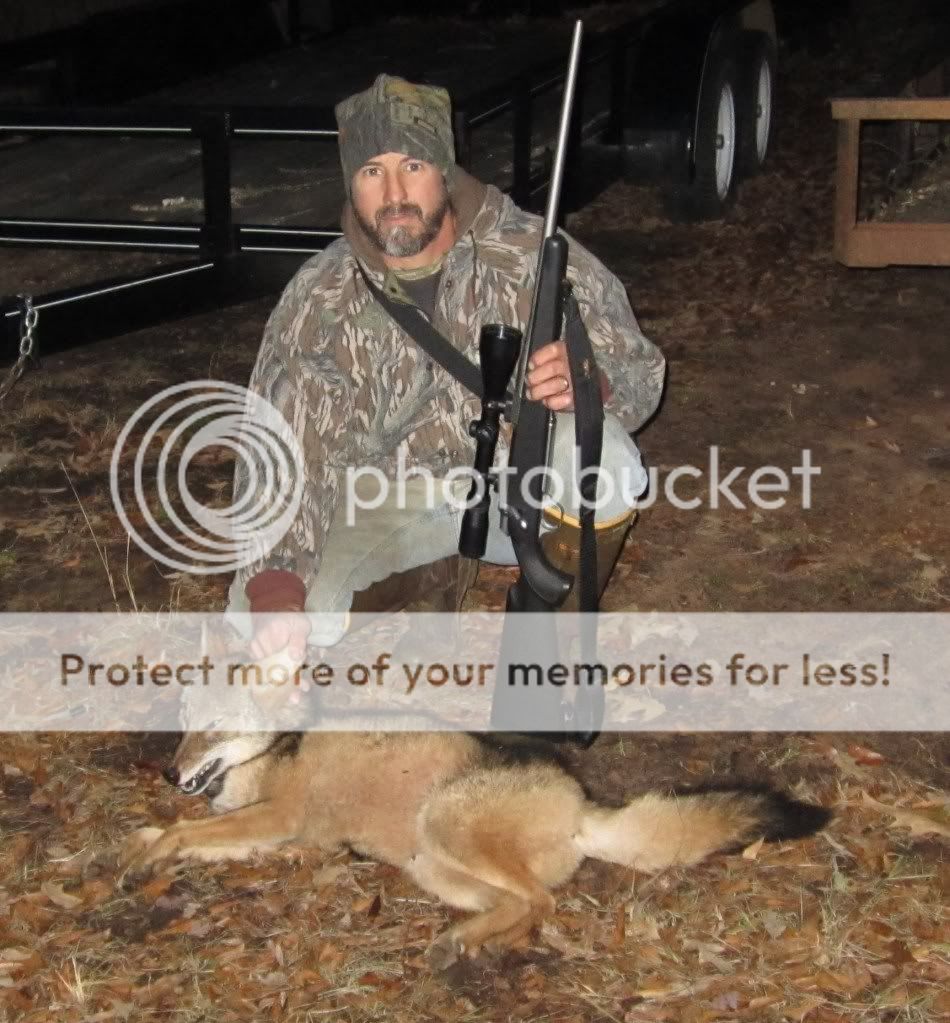Maybe a coydog=coyote+dog But I do have to say, those are some BIG canines!!!!
Navigation
Install the app
How to install the app on iOS
Follow along with the video below to see how to install our site as a web app on your home screen.
Note: This feature may not be available in some browsers.
More options
You are using an out of date browser. It may not display this or other websites correctly.
You should upgrade or use an alternative browser.
You should upgrade or use an alternative browser.
Coyotes have finally showed up
- Thread starter woodmort
- Start date
- Jan 1, 2011
- 187
- 1
- 99
Quote:
I doubt it... In MA, I've seen coyotes that have come in to the weigh station (hunting checkpoint? I don't know the terms) that have been in the high 50, low 60s. There's an 8 point buck corpse in my woods that has been ripped cleanly in half by the pack that runs through, and it's a small one.
Good luck with the coyotes. They have a 2-3 mile range usually, so hopefully they don't pass through too often.
I doubt it... In MA, I've seen coyotes that have come in to the weigh station (hunting checkpoint? I don't know the terms) that have been in the high 50, low 60s. There's an 8 point buck corpse in my woods that has been ripped cleanly in half by the pack that runs through, and it's a small one.
Good luck with the coyotes. They have a 2-3 mile range usually, so hopefully they don't pass through too often.
- Thread starter
- #13
- Jul 6, 2010
- 3,524
- 996
- 301
Quote:
No coydogs here. I posted this link on another thread but it has good information about eastern coyotes. http://www.pressconnects.com/apps/pbcs.dll/article?AID=201012220344
No coydogs here. I posted this link on another thread but it has good information about eastern coyotes. http://www.pressconnects.com/apps/pbcs.dll/article?AID=201012220344
Massive animals! This last snow was the first that I found tracks (this year) here in West central NJ. Asked the neighbor if he had seen them. He said no, but he had heard them the night before.
Out here in the Northeast the coyotes are a substantial (and I mean substantial) chunk wolf. They interbred long ago, I would guess when the legitimate wolf packs were hunted down to nothing and the wolves had to breed with coyotes or nothing. I would guess 40-50 lb would be average and I've heard of much larger; I know there was a 70-lb coyote killed up in Maine. People from the Southwest always look at me funny when I say we had to bring the dogs in (big dogs) because the coyotes were singing; they're picturing the little 20-pounders. Out here they look, act, and pack hunt like wolves.
- Apr 15, 2009
- 6,770
- 238
- 281
Well, I guess I spoke too soon earlier. I went out to lock the coop up at dusk and surprised a coyote who was scoping out the set-up.


- Jun 9, 2009
- 906
- 97
- 153
The books I referred to give track measurements separately for westerns, easterns, and wolves. Obviously there is overlap, but it would be interesting to know the range of track sizes those coyotes made, if you think they are very large. Are they in the wolf range? Coyotes in the northeast are amongst the biggest, and I believe New York has the largest.
As you may know, eastern coyotes have been shown to have DNA of both wolf and western coyote, and are intermediate in size and in degree of sociality between wolf and western coyote. Most are more like western coyotes than like wolves (and genetically over 90% western coyote), but some are very large and more wolf-like. A coyote biologist (Jonathan Way) here in Massachusetts collared a 70+ lb female coyote, though most are less than 50 lbs. He has a website, you can google if you want, but I think average weights of animals he has collared have been in the 30s and 40s.
No, you cannot calculate an exact weight from track measurements, but bigger tracks usually do mean bigger animal, and as a tracker, I find it fascinating to follow track sizes of different species over the years. Things like human land use patterns, hunting, trapping, and climate change all impact these animals. They have to adapt or evolve to cope with what we do to them, if they are to survive. Evolving to a somewhat more wolf-like creature is what coyotes of the east have done to meet these challenges.
As you may know, eastern coyotes have been shown to have DNA of both wolf and western coyote, and are intermediate in size and in degree of sociality between wolf and western coyote. Most are more like western coyotes than like wolves (and genetically over 90% western coyote), but some are very large and more wolf-like. A coyote biologist (Jonathan Way) here in Massachusetts collared a 70+ lb female coyote, though most are less than 50 lbs. He has a website, you can google if you want, but I think average weights of animals he has collared have been in the 30s and 40s.
No, you cannot calculate an exact weight from track measurements, but bigger tracks usually do mean bigger animal, and as a tracker, I find it fascinating to follow track sizes of different species over the years. Things like human land use patterns, hunting, trapping, and climate change all impact these animals. They have to adapt or evolve to cope with what we do to them, if they are to survive. Evolving to a somewhat more wolf-like creature is what coyotes of the east have done to meet these challenges.
Last edited:
- May 26, 2009
- 562
- 122
- 161


I got these two last week. The first I shot while deer hunting Friday evening. The second was about forty FEET from my front ddor when I stepped out the door last Sunday morning. I keep a .22 magnum above the front door....I grabbed it and stepped back out and got her when she stopped between my chicken tractor and the kids' trampoline.
Last edited:
- Thread starter
- #19
- Jul 6, 2010
- 3,524
- 996
- 301
chickortreat I've got two questions: Where is this? And what did they weigh? BTW I have a golfing friend who is also a taxidermist. He was asked last summer what his most common mounts were with the expected answer being deer. He said no, that in the past half dozen years more of the mounts he did were coyotes than deer for hunters in this area.
- May 26, 2009
- 562
- 122
- 161
Quote:
West central Alabama, and not sure about the weight though they are about average for around here, probably 30-35 pounds. After deer season, I intend to start pursuing them actively. I've killed five grey fox (from my front porch) since I got my chickens nearly two years ago.
West central Alabama, and not sure about the weight though they are about average for around here, probably 30-35 pounds. After deer season, I intend to start pursuing them actively. I've killed five grey fox (from my front porch) since I got my chickens nearly two years ago.
Last edited:
New posts New threads Active threads
-
Latest threads
-
-
-
-
What colors would these bantam Cochin hens fall under?
- Started by JarrodnJojo2016
- Replies: 1
-
-
-
Threads with more replies in the last 15 days
-
-
-
BYC Software Update 2025
- Started by Nifty-Chicken
- Replies: 173
-
Anyone trained their dog to stay away from chickens like this?
- Started by ChickenShepherd_6116
- Replies: 75
-
-
×

